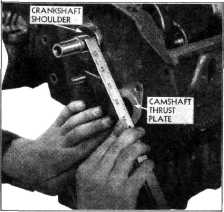1942 - 1947 CHEVROLET SHOP MANUAL
Section 6 - Engine
|
|
|||
|
6-11 |
|||
|
|
|||
|
2. Place a new front camshaft bearing over the
puller bar and start the bar
through the front bearing bore.
Place the puller sleeve with a new bearing over the bar before passing the
bar through the other bearing
bores in the cylinder
block. Pass the end of the bar through the puller bracket and install the
thrust bearing and turning handle.
3. Line up the oil holes in each bearing with
the oil hole location marks
previously made. All four
bearings can now be pulled into place at the same time.
4. Remove the puller bar and bracket and stake
each bearing into the hole
provided in the bore for that
purpose.
Reaming Camshaft Bearings
The special
camshaft bearing line reamer has all
four cutters mounted on one bar so that all bearings will be in perfect
alignment after the reaming
operation.
1. Pass the reamer through the first, second,
and third bearings. Then start
the reamer cutters into all
four bearings and turn the reamer slowly until the cutters have passed through
the bearings. While the
bearings are being reamed, a
liberal supply of kerosene should be used to wash out all metal
cuttings.
2. Remove the reamer by pulling it back
through the bearings, at the
same time turning the reamer
slowly in the same direction as when reaming the bearings.
3. Blow all cuttings from the bearings with
compressed air. Install
the camshaft and check all bearing clearances with a narrow feeler
gauge. The proper clearance is
from .002" to .004". Install
the expansion plug in- the back end of the cylinder block at the rear camshaft
bearing.
CAMSHAFT
The
camshaft is designed to assure quiet operation, combined with accurate valve timing.
The contour of each cam is
carefully worked out to take
up the valve clearance gradually, and all cams have a wear-resisting coating to
insure long life. The valve lifters are located slightly off the center
line of the cams. This design produces a spinning action to the lifter so the cams
do not engage the same point on
the lifters each time the valves open, resulting in long valve lifter
life and quiet operation.
The
following is a list of the sizes of the camshaft bearing journals: front,
2.0282"-2.0292"; front
intermediate, 1.9657"-1.9667'/; rear intermediate, 1.9032"-1.9042"; rear
1.8407"-1.8417".
Whenever a
camshaft is removed from an engine it
is important that these dimensions be checked with a micrometer for out-of-round.
If |
the
journals exceed .001" out-of-round, the camshaft should be
replaced.
Another
very important inspection operation, while the camshaft is out of the engine, is
to check it for alignment. The
best method is by use of "V"
blocks and a dial indicator as shown in Fig. 17. The dial indicator will indicate the
exact |
||
 |
|||
|
Fig. 17—Checking Camshaft Alignment
amount the
camshaft is out of true. If it is out more than .002" dial indicator reading, the
camshaft should be
straightened. When checking, the high reading of the dial indicator indicates
the high point of the shaft.
This point should be chalk
marked to tell exactly where to apply pressure when straightening.
NOTE—During the straightening
operation care should be taken to protect the bearing journals to prevent
damage to their surfaces.
After the
camshaft has been straightened, it should be re-checked to be sure it is
within .002" dial indicator
reading for alignment.
CRANKCASE FRONT END PLATE
This part
is assembled to the cylinder block with from one to three gaskets. The reason
for the varying number of gaskets is to provide the correct alignment for
the timing gears. |
|||
 |
|||
|
Fig. I8—Checking Timing Gear Alignment |
|||
|
|
|||